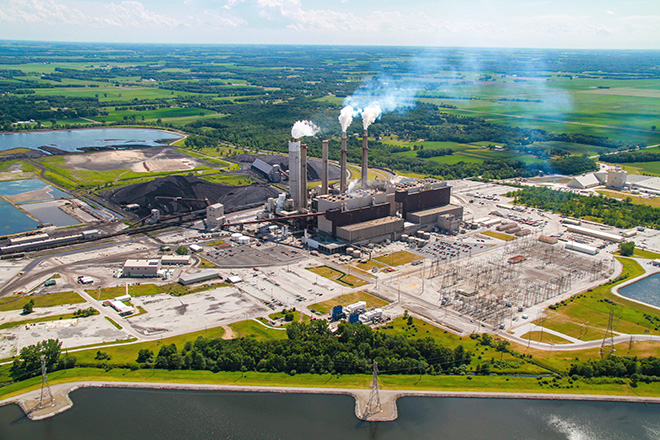Featured Topics
Featured Products
Events
S&P Global Offerings
Featured Topics
Featured Products
Events
S&P Global Offerings
Featured Topics
Featured Products
Events
S&P Global Offerings
Featured Topics
Featured Products
Events
Financial and Market intelligence
Fundamental & Alternative Datasets
Government & Defense
Banking & Capital Markets
Economy & Finance
Energy Transition & Sustainability
Technology & Innovation
Podcasts & Newsletters
Financial and Market intelligence
Fundamental & Alternative Datasets
Government & Defense
Banking & Capital Markets
Economy & Finance
Energy Transition & Sustainability
Technology & Innovation
Podcasts & Newsletters
29 Dec, 2021

By Allison Good

|
NiSource subsidiary Northern Indiana Public Service will retire the R.M. Schahfer coal plant by 2023. Some utilities are speeding their exits from coal amid mounting pressure to accelerate net-zero timelines. |
Some coal-heavy U.S. utilities could see their environmental, social and governance outlooks improve enormously in 2022 as the industry looks to accelerate its exit from the carbon-intensive fuel and set aside substantial capital for transmission and distribution projects aimed at renewable power supplies, sector experts said.
Pressure to decarbonize is prompting companies to aggressively revise their timelines for achieving net-zero emissions, according to Wells Fargo Securities analysts.
"It is truly a race ... and companies are all but tripping over themselves to exit coal generation," they told clients Dec. 1. "[CMS Energy Corp., DTE Energy Co. and WEC Energy Group Inc.] were among several utilities that articulated plans ... much faster than previously contemplated. We will go out on a limb and predict that '22 will bring another wave of accelerated coal unit retirements."
CreditSights expects that some ESG laggards will raise their environmental profiles based on the credit research firm's scoring system, which also awards numbers to the social and governmental components, as utilities continue to retire coal plants and replace them with natural gas or renewables generation.
"Some of the worst-scoring names currently (i.e., [American Electric Power Co. Inc., Duke Energy Corp.]) are among the highest-scoring names on a trajectory basis as these companies continue transitioning toward a cleaner fuel mix and we view these as the most compelling investments," CreditSights wrote Dec. 1, also pointing to CMS and DTE.
For Duke subsidiaries operating in North Carolina, state regulators approved a five-year action plan in November that includes the retirement of the 860-MW G.G. Allen coal-fired plant after updates advanced previously proposed retirement dates of Allen units 2 and 4 to 2022 and units 1 and 5 to 2024. In October, North Carolina enacted legislation to speed retirements and reduce carbon emissions by 70% by 2030 from 2005 levels.
However, PPL Corp., FirstEnergy Corp. and Eversource Energy "show minimal upside trajectory," according to CreditSights, with PPL's heavy exposure to coal continuing as it expects the fuel to "comprise about 50% of its ... mix by 2036."
Still, Wells Fargo said the utility industry overall has strong fundamentals going into 2022 largely due to decarbonization and electrification, even though stock prices are depressed.
"Our message to investors ... is simple: 'jump in, the water's fine,'" the analysts said.
The mismatch between equity valuations and those fundamentals means investors will likely continue to see the energy transition as a buying opportunity, bond research firm CreditSights said in its 2022 ESG forecast for the sector.
"The ESG investment thesis for utilities has been shifting over the past one-to-two years, with dozens of our ... client conversations going from a negative approach of 'sell anything with coal' to now a positive screening 'buy anything renewables' approach," CreditSights said.
Utilities focusing on beefing up electric transmission and distribution, in particular, may also improve their credit quality, CreditSights added.
According to Regulatory Research Associates, a group within S&P Global Market Intelligence, investments by the U.S. electric and multi-utility holdings companies it covers in transmission and distribution "appear to be on the upswing, approximately $61 billion in 2021 and rising to more than $63 billion in 2022 and 2023."
For example, AEP will use the proceeds from its $2.85 billion Kentucky asset sale to help finance about 10,000 MW of renewable capacity proposed through 2025 as part of a $37 billion capital plan that earmarks 72% of spending to transmission and distribution. Ameren Corp. is setting aside $3.7 billion for Ameren Transmission Co. and $2.7 billion for Ameren Illinois Co. electric distribution for 2021 through 2025.
However, sustainability benchmarking groups such as the World Benchmarking Alliance warned that the vast majority of the world's 50 leading utilities, including 10 U.S. power companies, are still exceeding their carbon budgets and falling behind the climate goals of the Paris Agreement on climate change. In its November assessment, Dominion Energy Inc., Southern Co. and Vistra Corp. earned a "C," while AES Corp. earned a "D."